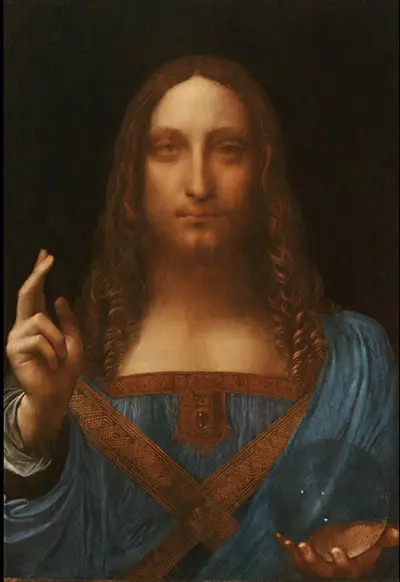Meaning Saviour of the World the painting was included in the 2011 Leonardo da Vinci: Painter at the Court of Milan exhibition at the National Gallery.
Completed around 1513 following a commission from Louis XII of France in 1506, the painting was bought in 2005 by a consortium of US art dealers who took 7 years to restore the work.
At the time of this purchase the painting was in very poor condition with the wooden panel having split and having seen crude attempts at repair and restoration. In such condition it would have been extremely difficult to authenticate, and as recently as 1958 it was sold for just £45, being believed to have been by da Vinci's pupil Boltraffio.
Salvator Mundi was known to have been in the collection of Charles I of England. However until its recent discovery it was thought there only remained a number of copies plus a very similar detailed etching from 1650 by Wenceslaus Hollor who may have had access to the original at the Royal Court.
Comparing the painting against two preparatory drawings by da Vinci held in the Royal Library assisted in its verification, as did finding pigments and wood panelling consistent with other da Vinci paintings during the restoration.
Of course analysis of technique by Leonardo da Vinci experts contributed significantly to the painting being accepted as an original. The glass orb that Christ is holding, although not a traditional Roman Catholic representation of the orb, is incredibly intricate in its portrayal of light, something which da Vinci was very interested in.
Copies of the work do not have the detail in the knuckles of the right hand, something you would expect in someone well versed in anatomy. The quality and intricacy of the overall design is far superior to what the many imitators of his work at that time would have been able to produce.
The Saviour of the World is an ancient characterisation of Christ. Leonardo da Vinci's depiction is with oil on a wooden panel, the dimensions of which are 65.6cm by 45.4cm. Featuring another da Vinci trait of ringlets and spirals it depicts Christ with his right hand raised in benediction.
The heel of the other hand holding the orb has interested experts as it is suggestive of a double-wide heel. This would be consistent with the distortion caused by glass or crystal, and Leonardo da Vinci had an interest in this developing area of optics.
Accrediting a painting as a long-lost work by a master like Leonardo da Vinci is not done lightly, so the National Gallery including it in its exhibition was a statement in itself. The soft, almost elusive image of Christ also calls to mind the central image in The Last Supper.
Leonardo da Vinci was a master of his craft, who his many imitators could not get near replicating, and Salvator Mundi is a worthy example of the intricacies of his work.


